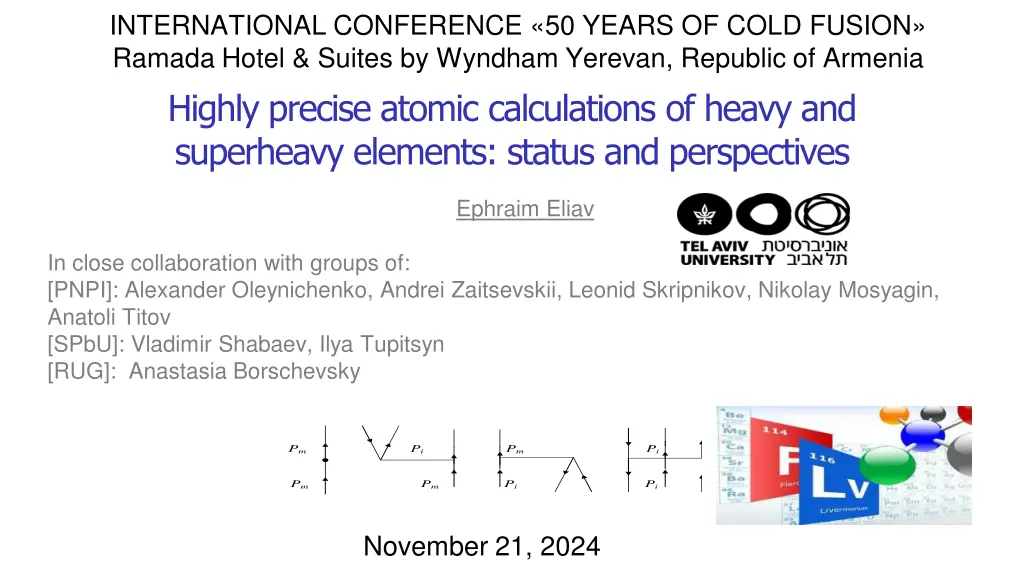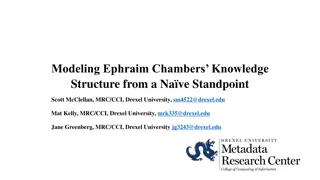
Atomic Calculations of Heavy Elements: Status & Perspectives
"Explore the highly precise atomic calculations of heavy and superheavy elements presented at the International Conference celebrating 50 years of cold fusion. Learn about benchmark precision, relativity treatment, and the current framework for comprehensive calculations in modern physics experiments."
Download Presentation

Please find below an Image/Link to download the presentation.
The content on the website is provided AS IS for your information and personal use only. It may not be sold, licensed, or shared on other websites without obtaining consent from the author. If you encounter any issues during the download, it is possible that the publisher has removed the file from their server.
You are allowed to download the files provided on this website for personal or commercial use, subject to the condition that they are used lawfully. All files are the property of their respective owners.
The content on the website is provided AS IS for your information and personal use only. It may not be sold, licensed, or shared on other websites without obtaining consent from the author.
E N D
Presentation Transcript
INTERNATIONAL CONFERENCE 50 YEARS OF COLD FUSION Ramada Hotel & Suites by Wyndham Yerevan, Republic of Armenia Highly precise atomic calculations of heavy and superheavy elements: status and perspectives Ephraim Eliav In close collaboration with groups of: [PNPI]: Alexander Oleynichenko, Andrei Zaitsevskii, Leonid Skripnikov, Nikolay Mosyagin, Anatoli Titov [SPbU]: Vladimir Shabaev, Ilya Tupitsyn [RUG]: Anastasia Borschevsky PmPi PmPi Pm PmPi Pi November 21, 2024
Highly precise = benchmark Benchmark precision for atomic and molecular energy spectra and other properties calculations, suitable for modern spectroscopy and new physics experiments is less then 0.1% (meVs or less for energy) In heavy systems benchmark right for the right reason treatment of relativity(+ QED) & electron correlation effects should be done: 1) simultaneously, and on equal footing, by tunable and controllable fashion 2) efficiently and up to high orders , multi-referencely (for quasi-degenerate cases) 3) size-intensively ( proper size-scaling: E=O(N)) and size-consistently (proper decomposition: E(A+B)=E(A)+E(B); (A+B)={ (A) (B)} )
Current benchmark framework for relativity (and QED) treatment Dirac-Coulomb-Breit(DCB) Hamiltonian and no-virtual-pairs approximation (NVPA) Not covariant, correct to 2; Mini-Max SCF; Sucher, 1980, derived from QED: N N N ( ) i + + + + + = + + ( ) (1 ) H N h r B U DCB D i j ij ij j i i i i j i r r r r r where hd single electronic Dirac Hamiltonian: i projection onto the positive energy-spectrum of hd U SCF ; V a finite size nuclear potential; Vext- external fields (including nuclear and QED corrections by using model potentials (MP)): = + + + + ext 1 ( ) ( ) ( ) r ( ) h c p V r V U r D Vacuum Polarization = (Uehling model potential) Self-energy = (Shabaev-Tupitsyn-Erokhin model potentials) r r r r r r 1 ( )( ) = + 2 / B 12 r 12 r 12 r Energy independent Breit interaction: 12 1 2 1 2 2 12 r Excellent approximations for DCB Hamiltonian (within finite basis set): exact two-component (X2C), and relativistic effective-core/pseudo- potential (RECP/RPP)
Relativistic Hamiltonian revised: generalized relativistic effective-core/pseudo- potentials (GRECP/GRPP) valence and outercore electrons are described by the two-component effective NR(!) Hamiltonian: i , j sum over electrons sum over nuclei z effective charge of an inner core of an atom , z = Z Ninner-core elec-s GRPP pseudopotential U substitute inner core (small amount) electrons and effectively includes: scalar-relativistic effects spin-orbit interaction Breit e-e interaction finite nuclear charge distribution (Fermi model) leading QED effects (via Uehling & Shabaev-Tupitsyn-Erokhin model operators) special non-local treatment of outer core electrons (in addition to regular semilocal part ) a very precise formulation: typical energy spectra error < 50 cm 1 relative to DCB values interfaced with DIRAC, MOLCAS, MOLPRO and CP2K via the LIBGRPP library (by A. Oleynichenko)! A. V. Titov, N. S. Mosyagin, IJQC 71, 359 (1999); A. Zaitsevskii, N. S. Mosyagin, A. V. Oleynichenko, E. Eliav, Int. J. Quantum Chem. e27077 (2022)
Relativistic coupled cluster as a benchmark method for solution of SE: H = E , where H=H0+V and H0 0= E0 0 An extremely powerful method for treatment of electron correlation Exponential representation of the wave operator: Here, S is the excitation operator, usually truncated at S2(Couple Cluster Single and Doubles (CCSD) approximation): Coupled cluster equations in the single reference (SR) case: 0= 0 (single Slater determinant, usually SCF function) [Sn,H0]=(Vexp(S))c (for every n) Golden standard of Quantum Chemistry: CCSD(T): ECCSD(T)= ECCSD+ E(T), where E(T)is the perturbative triples correction , based on the following approximation: [S3,H0] (VS2)c
Relativistic coupled cluster as a benchmark method for solution of SE: H = E , where H=H0+V and H0 0= E0 0 An extremely powerful method for treatment of electron correlation Exponential representation of the wave operator: Here, S is the excitation operator, usually truncated at S2(Couple Cluster Single and Doubles (CCSD) approximation): Highly accurate and efficient Equivalent to infinite order perturbation expansion Size extensive (energy scales linearly with number of electrons/size of basis set) Size consistent (proper decomposition of energy and wave function) Coupled cluster equations in the single reference (SR) case: 0= 0 (single Slater determinant, usually SCF function) [Sn,H0]=(Vexp(S))c (for every n) Golden standard of Quantum Chemistry: CCSD(T): ECCSD(T)= ECCSD+ E(T), where E(T)is the perturbative triples correction , based on the following approximation: [S3,H0] (VS2)c
Variants of the benchmark relativistic coupled cluster methods Relativistic single reference coupled cluster with single, double, and perturbative triple excitations: SR-CCSD(T) was recently extended to SR-CCSDTQP within new version of the DIRAC code: T. Saue, R. Bast, A. S. P. Gomes, H. J. A. Jensen, L. Visscher, I. A. Aucar, R. Di Remigio, K. G. Dyall, E. Eliav, et al The DIRAC code for relativistic molecular calculations, J. Chem. Phys. 152 (20) (2020) 204104. - Closed shell systems/systems with one dominant configuration - Ground state and lowest excited states Multi reference (MR) coupled cluster, in particular, Fock space coupled cluster (FSCC): (m,n)= exp{Sl(m,n)} 0 Valence sectors: m-holes, n-particles; Implemented: m+n 3, correlation level: FS-CCSDT, within the EXP-T code: Oleynichenko, A.V., Zaitsevskii, A., Eliav, E. (2020). The EXP-T Program Package. In: Supercomputing. RuSCDays 2020. Communications in Computer and Information Science, vol 1331. Springer, Cham. - Open shell systems, systems of multireference character - Ground state and excited states (many transition energies simultaneously) - Procedure is based on Subsystem Embedding Condition (SEC): 1. Start from some closed shell reference 0. Solve CC eq. for (0,0) sector. 2. Add (remove) electron. Iterate CC for either (0,1) or (1,0) sector. 3. Add (remove) electron... Till convergence in sector (n,m): Q(m,n)[Sl(m,n),H0]P(m,n)= Q(m,n)(Vexp(S)-exp(S)Heff)cP(m,n) 4. Diagonalise Heff=P(m,n)(V (l,r m,t n)exp{Sl(r,t)} )cP(m,n)where P(m,n) 0= 0(m,n)and P(m,n)+ Q(m,n)=I(m,n) Recent review: E. Eliav, A. Borschevsky, A. Oleynichenko, A. Zaitsevskii, U. Kaldor, Reference Module in Chemistry, Molecular Sciences and Chemical Engineering (2021).,
Relativistic SR-CCSDTQP (+Breit+QED) : Reaching meV accuracy in IP of Au L. F Pa teka, E. Eliav, A. Borschevsky, U. Kaldor and P. Schwerdtfeger, PRL, 118, 023002 (2017) Nonadditive Interplay of Correlation, Relativity and QED E (eV) IP (eV) 4c-SR-CCSD(T) 9.2937 0.0681 Golden standard 4c-SR-CCSDTQP 9.2697 0.0441 +Breit (SCF) 9.2565 0.0309 +Breit (CC) 9.2541 0.0285 +QED (SCF) 9.2333 0.0077 +QED (CC) 9.2288 0.0032 Beyond Golden Standard: (Correlation [TPQ] ) (Breit) (QED) IP (exp.)=9.2256 eV Still missed: tiny QED & nuclear effects
Benchmark applications of the multireference FS CCSDT model in low sectors Ionization potentials and excitation energies of the Tl and Pb atoms, cm 1 A. Oleynichenko, A. Zaitsevskii, L. V. Skripnikov, E. Eliav, Symmetry, 12(7), 1101 (2020) Pb+2(0,0) Pb+1(0,1) Pb(0,2) Tl+1(0,0) Tl(0,1) CCSD CCSDT few meV accuracy achieved GRECP+FSCCSDT+natural orbitals (NO): the most accuratecalculations of non-alkali atoms? [47] A. Landau, E. Eliav, Y. Ishikawa, U. Kaldor, J. Chem. Phys. 114, ,2977 (2001) [84] J. E. Sansonetti, W. C. Martin, J. Phys. Chem. Ref. Data, 34, 1559 (2005)
0h3p sector: refinement of the quadrupole moments of Bi isotopes L. V. Skripnikov, et al, Phys. Rev. C 104(3), 034316 (2021) how to extract nuclear electric quadrupole moment Q from experimentally measured HPF constant B: B [MHz] Q [b] = 234.9648867 q [a.u.] q electric field gradient (EFG) on a nucleus, calculated using Finite Field approach Bi+3(0,0) Bi+2(0,1) Bi+1(0,2) Bi(0,3)
Benchmarking of SHEs: Theoretical Uncertainty Estimates Experiment Method 1: Missing Effects Analysis Evaluate magnitude of omitted computational factors Consider: Basis set incompleteness Higher-order relativistic effects Higher-order correlation effects Requires systematic study using hierarchical computational approaches Method 2: Similar System Comparison Compare calculations with experimental data from analogous systems Typically use lighter homologues with similar electronic structure Use theory-experiment discrepancy to estimate uncertainty Method 3: Different Similar Precision Benchmark Approaches Comparison Use discrepancy between different benchmark approaches (for instance: SR-CC versus FS-CC) to estimate uncertainty
IPs and EA (eV) of Nh: FS-CCSDT versus SR-CCSDTQ FSCC: Kaygorodov, et al, PRA,105,062805 (2022) | SRCC: Guo, et al, JPB, 55, 155003 (2022) DCB FSCC scheme: SSR-CCSDTQ+B+QED
SR-CCSDTQ(+Breit+QED): IPs and EAs (eV) of In, Tl, and Nh Y. Guo, A. Borschevsky, E. Eliav and L. F Pa teka, J. Phys. B: At. Mol. Opt. Phys. 55 155003, 2022 Theoretical uncertainty estimates
IP & EA of Oganesson: convergence of benchmark approaches Reference Method IP, eV EA, eV E. Eliav, U Kaldor, Y Ishikawa, P Pyykk , PRL, 77,5350 (1996) I. Goidenko, L Labzowsky, E Eliav, U Kaldor, P Pyykk , PRA,67,020102 (2003) B. Lackenby, VA Dzuba, VV Flambaum, PRA, 98, 042512 (2018) FSCCSD+Breit 0.056(10) FSCCSD+Breit+QED 0.058(3) CI+MBPT (+Breit+QED) 8.866 0.096 SR-CCSDT(Q)+Breit+QED Y. Guo, LF Pa teka, E Eliav, A Borschevsky, AQC,83,107(2021) Kaygorodov, LV Skripnikov, II Tupitsyn, E Eliav et al, PRA,104,012819(2021) 8.888(44) 0.080(5) FSCCSDT+Breit( )+QED 0.076(4) Missing effects convergence: Effect of the basis set cardinality, the level of augmentation, and the treatment of electron correlation on the calculated IP (left) and EA (right) of Oganesson by the SR-CC approach.
Molecular benchmark CC applications: excited states of the ThO Term energies Te , cm 1 [A. Zaitsevskii, A. V. Oleynichenko, E. Eliav, Mol. Phys. e2236246 (2023)] exptl, cm 1 deviation from experiment, cm 1 GRPP/FS-CCSD 0h2p 0h2p DC/FS-CCSD 1h1p H(i)1 Q(i)2 A(ii)0+ B(ii)1 C(iii)1 D(iv)1 E(iii)0+ G(iv)2 F(iv)0+ I(vi)1 5317 6128 10601 11129 14490 15946 16320 18010 18338 19539 104 97 242 302 424 440 312 165 431 367 700 738 691 927 1698 1700 960 -149 -62 1098 -39 -1950 [present work] [Tecmer et al, PCCP, 2018] Relativistic Hamiltonian: GRPP accounting for Breit and QED Ground state calculations: single-reference coupled cluster CCSD(T) Excited states: (IH-IMS) Fock space coupled cluster FS-CCSD Why ThO? A popular objects to search for electron electric dipole moment ACME Collaboration, Nature, 562, 355 (2018)
Molecular applications: excited states of the ThO molecule Lifetimes of excited states [A. Zaitsevskii, A. V. Oleynichenko, E. Eliav, Mol. Phys. e2236246 (2023)] Transition dipole matrix elements were calculated as effective operators correct to second order in excitation operator S exptl theory 4.2 0.5 msa H X 3.82 ms > 62 msb Q X 177 ms > 480 nsc 468 30 nsd C X 400 ns 5.4 1.3 msb 5.49 s C Q a D. G. Ang et al, Phys. Rev. A 106, 022808 (2022); b X. Wu et al, New J. Phys. 22, 023013 (2020) c N. R. Hutzler et al, Phys. Chem. Chem. Phys. 13, 18976 (2011); d D. L. Kokkin et al, Phys. Rev. A 91, 042508 (2015)
Benchmark calculations for SHE molecules: an easy way with GRECP N. Mosyagin et al, Generalized relativistic effective core potentials for superheavy elements, IJQC, 120 (2020), e26076
Summary Breakthrough in accuracy = [4c-DCB/2c-GRPP(Breit) + QEDmod] + [FS-CCSDT/SR-CCSDTQ] + [Natural Orbitals basis sets] Efficient implementation of FSCCSDT & high sectors (EXP-T code); SR-CCSDTQ (DIRAC code) However, for a general quasi-degenerate (open shell) system there could be problems within FSCC: max 3 unpaired electrons... 4-valence electron/holes FSCC calculations could be very complicated! poor relaxation in low lying sectors; limited non-dynamic correlation other MRCC Ansatzs and Intermediate Hamiltonian (generalization of Heff) formulation: Mix-sector CC IH: further development Relativistic ic-MRCC (closely related to the non-normal ordered FSCC): is being implemented by A. Oleynichenko based on A. K hn s GeCCo code extremely high computational cost: CCSD(T) (~ N7), CCSDT(~ N8), CCSDTQ (~ N10), CCSDTQP (~ N12) localization techniqueswithin Natural Orbitals contraction techniques : Tensor Trains Thanks for your attention!






















